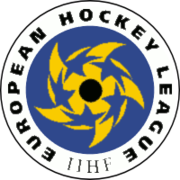European Hockey League
The IIHF European Hockey League ( EHL for short ) of the International Ice Hockey Federation IIHF was the successor to the European Cup , which was held from 1965 to 1996, and the forerunner of the IIHF European Champions Cup held from 2005 to 2008 and the first and only in 2008/09 Times the Champions Hockey League .
From 1996 to 2000, the European Hockey League was the most important ice hockey tournament for club teams in Europe . The IIHF invited the champions and other qualified teams of the first leagues of the countries. In the first season of 1996/97 the European Champions Cup took place in parallel, so that some national champions took part in the EHL, others in the national champions cup. The winner of the competition met the winner of the European Champion's Cup in 1997 in the IIHF Super Cup . After his adjustment, the EHL winner met the winner of the IIHF Continental Cup between 1998 and 2000 .
The IIHF discontinued the EHL in 2000 because the response from the most important leagues in Europe was too low and television rights could not be sold accordingly. The role of the highest club competition first took the IIHF Continental Cup , later the IIHF European Champions Cup . In the 2008/09 season, the Champions Hockey League, a competition similar to the European Hockey League, was introduced.
mode
In each of the four years of the competition, there was a different format, mainly due to the different number of participants.
In the first season of 1996/97 , which was played parallel to the European Cup , 20 teams took part in the tournament. These were divided into five groups of four teams each, which played against each other in the league system . The five group winners and the three group runners-up with the best points qualified for the quarter-finals, which were also played in the two-legged mode. The four winning teams from these pairings reached the so-called Final Four , for which one of the semi-finalists was the host for each of the four years that the competition was held. Within two days, the clubs then played the tournament winner.
For the following year , a total of 24 teams played in six preliminary round groups of four teams, with the six group winners and the two best runners-up qualifying for the quarter-finals. The rest of the mode remained untouched, with the exception that in the preliminary round groups there was a change from the two-point rule with a tie to a three-point rule with wins and losses after overtime or penalty shootouts .
The mode was changed drastically for the first time in the 1998/99 season . As in the previous year, 24 teams, divided into six groups of four teams each, took part. After they had played out the placements within the groups in the league system, the first and second placed reached the playoff round. There, one of the group winners met one of the runners-up. After the six winners had been determined in the first and second leg, they again played the first two places in two groups of three. In the Final Four , consisting of the two semi-finals, the game for third place and the final, they finally determined the tournament winner.
In the last year of the event , only 16 teams played the tournament winner. From the four preliminary round groups of four clubs each, the two first-placed teams reached the quarter-finals. Since the mode had been brought back into line with the first two years of the competition, the eight quarter-final qualifiers determined the winners who qualified for the Final Four and played out the tournament winner in the first and second legs.
Winners list
| year | Attendees | winner | Erg. | Final opponent | Venue |
|---|---|---|---|---|---|
| 1996/97 | 20th |
|
5: 2 |
|
Turku , Finland |
| 1997/98 | 24 |
|
5: 3 |
|
Feldkirch , Austria |
| 1998/99 | 24 |
|
2: 1 a.d. |
|
Moscow , Russia |
| 1999/00 | 16 |
|
2-0 |
|
Lugano , Switzerland |
literature
- Stephan Müller: International Ice Hockey Encyclopaedia: 1904 - 2005 . Books on Demand, Norderstedt, Germany 2005, ISBN 978-3-8334-4189-9 , pp. 436-442 .
